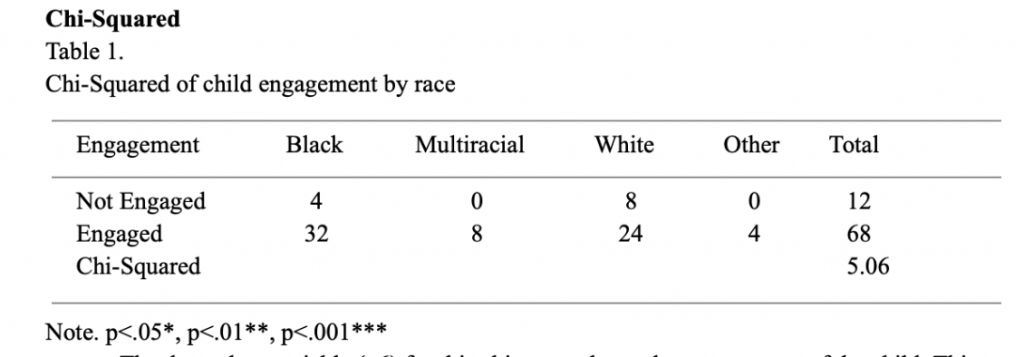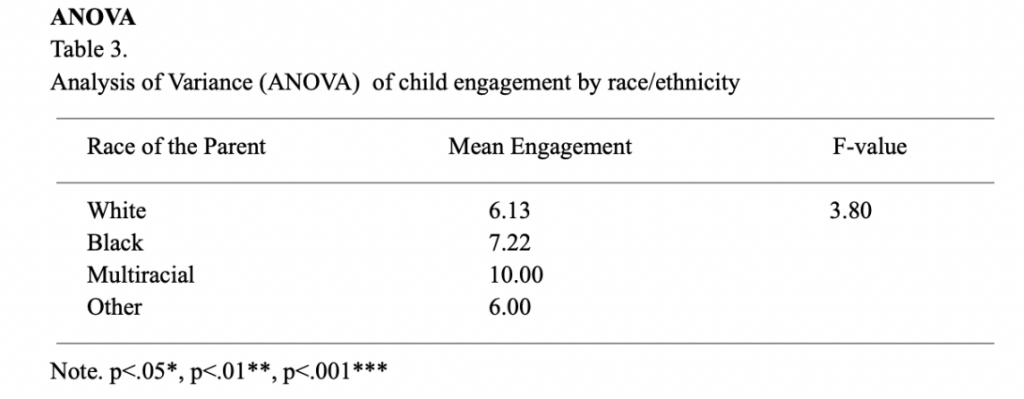Findings
Introduction
The survey conducted by Longwood University sociology students for this study was sent home with students from Head Start and the Andy Taylor Center last semester. My group was assigned the activity “Finger Friends’ ‘. The results found from this data can not be significant due to the fact that the data collected had to be duplicated in order to meet the learning needs of the Longwood University sociology students. In this study, the research question was “Would the race of the child’s parent have an effect on the level of family involvement?” The dependent variable (v6) in this study was parent involvement. Parent involvement was measured on a scale of 0-10 with 0 not being involved at all and 10 being involved a great amount. The independent variable (v32) in this study was the race of the child’s parent. This was measured by asking the parents to select their race/ethnicity and the options were Latino/Hispanic, White, African-American, Asian, Pacific Islander, Native American, Middle Eastern, Multiracial or Other. The finding section of this study will analyze both the independent and dependent variables using three different statistical tests, a Chi-Squared, an Independent Samples T-test and an ANOVA.
Chi-Squared
Table 1.

The dependent variable (v6) for this chi-squared was the engagement of the child. This was asked as not engaged or engaged. The independent variable (v32) for this chi-squared was the race/ethnicity of the child’s parent. Respondents chose either, “white”, “black”, “multiracial”, or “other”. 12 total parents reported that their child was not engaged. 68 total parents reported that their child was engaged. 4 parents that identified as black, 0 parents that identified as multiracial, 8 parents that identified as white and 0 parents that identified as other reported that their child was not engaged. 32 parents that identified as black, 8 parents that identified as multiracial, 24 parents that identified as white and 4 parents that identified as other reported that their child was engaged. According to the chi-squared results (chi-squared =5.06) there is not a significant difference between the categorical variables. In order to run this Chi-Squared test, I had to recode both my independent and dependent variable. My dependent variable was recoded into two groups that were Not Engaged and Engaged. Individuals who answered 0-5 were Not Engaged and Individuals who answered 6-10 were Engaged. My independent variable was recoded into 4 groups that were Black, multiracial and other. The previous categories were Latino/Hispanic, White, African-American, Asian, Pacific Islander, Native American, Middle Eastern, Multiracial or Other.
T-Test
Table 2.

The mean parent involvement score for parents identifying as “White” is 6.125 out of 10 and the mean parent involvement score for parents identifying as “Other Race” is 7.583 out of 10. The t-test value is 1.985 and it is not significant. This means that the mean parent involvement score is not significant between the two parent race categories. In order to run this Independent Samples T-Test, I recoded the independent variable into 2 categories that are “White” and “Other Race”. The previous categories were Latino/Hispanic, White, African-American, Asian, Pacific Islander, Native American, Middle Eastern, Multiracial or Other.
ANOVA

The dependent variable (v6) for this ANOVA was engagement of the child. This was asked on a 0-10 scale with 10 being extremely engaged and 0 not being engaged at all. The independent variable (v32) for this ANOVA was race/ethnicity. Respondents chose either, “white”, “black”, “multiracial”, or “other”. The mean engagement for children with white parents was 6.125 out of 10. The mean engagement for children with black parents was 7.22 out of 10. The mean engagement for children with multiracial parents was 10.00 out of 20. The mean engagement for children with parents of other races/ethnicities was 6.00 out of 10. According to the ANOVA results (F= 3.80) there is no significance found. Therefore, race/ethnicity does not influence child engagement.My independent variable was recoded into 4 groups that were Black, multiracial and other. The previous categories were Latino/Hispanic, White, African-American, Asian, Pacific Islander, Native American, Middle Eastern, Multiracial or Other.
Conclusion After using an Independent Samples T-test, a Chi-Squared and an ANOVA to analyze the research question that was “Would the race of the child’s parent have an effect on the level of family involvement?”, it is clear that there is no significance between the level of family involvement and the race of the parent. The Independent Samples T-test, the Chi-Squared and the ANOVA did not show significance at any level. With that being said, it must be taken into consideration that the data set was duplicated due to the fact that the response rate of the survey was so small. A larger and more accurate sample could potentially give the researcher more accurate results.
